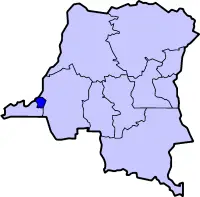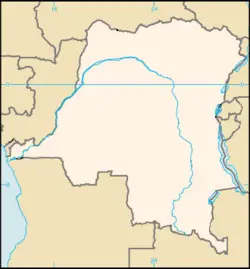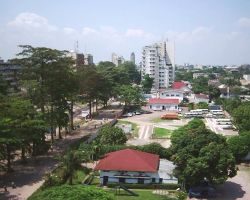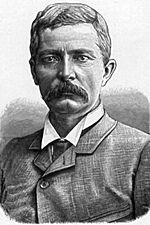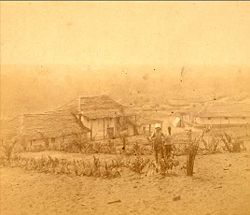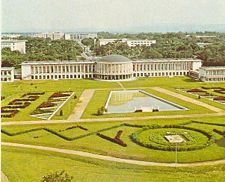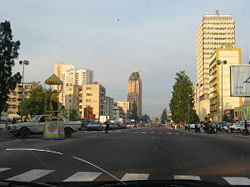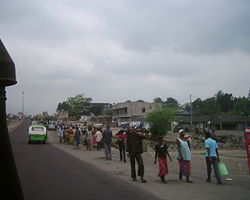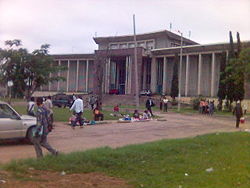Kinshasa
| Kinshasa Ville de Kinshasa |
|||
| â  Ville-province (city-province)  â | |||
| Kinshasa with Congo river in background | |||
|
|||
| Nickname: Kin la belle (English: Kin the beautiful) |
|||
| DRC, highlighting the city-province of Kinshasa | |||
| DRC, highlighting the city-province of Kinshasa | |||
| Coordinates: 4°20âČS 15°19âČE | |||
|---|---|---|---|
| Country | |||
| Province | Kinshasa | ||
| Administrative HQ | La Gombe | ||
| Communes | List
|
||
| Government | |||
|  - Governor | André Kimbuta | ||
| Area [1] | |||
|  - City-province | 9,965 kmÂČ (3,847.5 sq mi) | ||
| Elevation | 240Â m (787Â ft) | ||
| Population (2012)[1] | |||
| Â -Â City-province | 9,463,749 | ||
|  - Density | 949.7/kmÂČ (2,459.7/sq mi) | ||
| Â - Language | French | ||
| Website: www.kinshasa.cd | |||
Kinshasa (LĂ©opoldville until 1966), the capital and largest city of the Democratic Republic of the Congo, is in the west of the country along the south bank of the Congo River, directly opposite the city of Brazzaville, capital of the Republic of the Congo. This is the only place in the world where two national capital cities are situated on opposite banks of the same river within sight of each other. Kinshasa ties with Johannesburg for the status of the second largest city in sub-Saharan Africa and the third largest in the whole continent after Lagos and Cairo. Together with Brazzaville, the combined conurbation of Kinshasa-Brazzaville has nearly 9 million inhabitants.
A colony of Belgium, the country received its independence in 1960. Since that time, the DRC has experienced exploitation, ethnic strife, civil war, and human rights abuses. As a result, the nation suffers from dire poverty, famine, and disease. Rapid population growth in the capital has created food shortages.
Kinshasa is officially nicknamed âKin la Belleâ (Kinshasa The Beautiful), but with the collapse of public services and neglect in the early twenty-first century, some of its residents have ironically changed the nickname into âKin la Poubelleâ (Kinshasa the dustbin). However, Kinshasa-Congo's people and abundant natural resources could make the city prosperous with the return of stability.
Geography
Kinshasa is located 320 miles (515 km) inland from the Atlantic Ocean just south of the equator. The city is surrounded by intensely farmed savanna and gallery forest. Partly encircled by higher ground, the city is fairly level, with an altitude between 918 and 1148 feet (280 and 350 meters). Crops in the area include cassava, sugarcane, oil palms, plantains, corn, peanuts, and beans.
The total land area under city government is 3,847 square miles (9965 square kilometers), but much is sparsely populated, with the most heavily populated area covering 58 square miles (150 square kilometers).
Located near the Equator, the climate is quite consistent year-round, with the January temperature being a humid 70°F-88°F (21°C-31°C) and July being 64°F-81°F (18°C-27°C). The average yearly rainfall is around 53 inches (1358mm). The dry season is from June to August while the wet season has two rainfall maxima: one in MarchâMay and another in SeptemberâNovember. The rainy season is not unpleasant. Except for perhaps one rainstorm every few days, lasting from one to two hours, the skies are usually blue and sunny. In contrast, the dry season has overcast and cooler days.
The Congo River is the second longest river in Africa after the Nile, and is the largest in terms of discharge. As a waterway it provides a means of transport for much of the Congo basin, being navigable for large river barges between Kinshasa and Kisangani, with many of its tributaries navigable. The river is an important source of hydroelectric power, and downstream of Kinshasa it has the potential to generate enough power to supply the whole continent.
The large urban population has extensively eroded the surrounding countryside. Overcultivation has exhausted the soil, and trees cut for charcoal have not been replaced.
Kinshasa is a city of sharp contrasts, with affluent residential and commercial areas and three universities next to sprawling slums. There is an industrial zone along the western edge of the city. The riverside district of Gombe houses the European population, the Congolese elite, government buildings and embassies. A commercial area, the location of the wide Boulevard du 30-Juin, is in the east of the city. Kinshasaâs northern waterfront has quays and large warehouses. Ndolo has port facilities and industry. The poorer areas extend south. The CitĂ© de l'OUA is home to the Government of the Democratic Republic of the Congo, and the Commune de Matonge is known regionally for its nightlife.
History
Human settlement in the Kinshasa area has stretched back to at least the first millennium B.C.E. In the Pool Malebo area, the Tio (or Bateke) populated the right side (north) of the river and others assimilated with the Téké culture (Humbu and Mfinu peoples) resided on the left side (south) of the river. The slave and ivory trade played a significant role in the economy, and enriched the Tio kingdom.
From the sixteenth to seventeenth centuries, the Pool region became an important hub between the river and coastal areas. Vegetables from the Americas were introduced. Fishermen and traders occupied two villages thereâNshasa and Ntamo. By the 1880s, British trading firms were dealing in ivory, copper, and palm oil, and British and American missionaries were active there.
City founded as LĂ©opoldville
Henry Morton Stanley (1841-1904), a British journalist famous for his exploration of Africa, and for his search for Scottish minister David Livingstone in 1871, befriended an ivory trader who ruled the villages of Nshasa and Ntamo. Stanley acquired a trading post site there in 1881, and named it LĂ©opoldville in honor of King Leopold II of Belgium, who formally acquired the Congo territory at the Conference of Berlin in 1885.
The post flourished as the first navigable port on the Congo River above Livingstone Falls, a series of rapids over 190 miles (300km) below Leopoldville. At first, all goods arriving or being sent by sea had to be carried by porters between LĂ©opoldville and Matadi, the port below the rapids and 93 miles (150 km) from the coast.
King Leopold developed rubber plantations. Between 1885 and 1908, about ten million Congolese died as a consequence of exploitation and disease. The completion of the Matadi-Kinshasa portage railway in 1898 provided a faster and more efficient alternative route around the rapids and sparked the rapid development of LĂ©opoldville. International protests against exploitation forced the Belgian parliament, in 1908, to take over the Free State as a colony. It was known as the Belgian Congo from 1908 to 1960.
Exploitation of Congo's mineral and agricultural riches continued, with much of the work being done by forced labor. Europeans flocked into the new urban areas, but the majority of Congolese continued to live in traditional rural villages. A pipeline from Matadi to LĂ©opoldville to carry crude oil for steamers that worked upriver from LĂ©opoldville, was completed in 1914. An air service between LĂ©opoldville and Stanleyville began in 1920, at which time the capital of the Belgian Congo was moved from Boma in the Congo estuary, to LĂ©opoldville.
Independence and Africanization
As the capital city, Kinshasa has witnessed periods of violence as the country struggled with democracy and independence. In 1955, Westernized, mission-educated Africans, called évolués, initiated a campaign to end inequality. In May 1960, the Mouvement National Congolais, led by Patrice Lumumba (1921-1961), a fiery orator, won the parliamentary elections. Lumumba was appointed prime minister, and Joseph Kasavubu (1910-1969) was chosen as president.
The Belgian Congo achieved independence on June 30, 1960. Within days, the provinces of Katanga, led by Moise Tshombe (1919-1969), and South Kasai, had seceded, and violence had erupted against Europeans. United Nations troops were rushed in, but when Lumumba tried to use them against the Katanga separatists, the UN withdrew support, so Lumumba turned to the Soviet Union for help.
Mobutu Sese Seko (1930-1997), who was chief of staff of the new Congo army, seized control on September 14, 1960, in a coup sponsored by the United States Central Intelligence Agency, putting Lumumba under house arrest for the second time and keeping Kasavubu as president. Mobutu ordered the Soviets to leave. Lumumba was assassinated by Tshombe's followers, who were finally defeated in August 1961. Amid widespread confusion, corruption, and renewed violence, several civilian governments took over in quick succession, until the military took over again under Mobutu. With U.S. support because of his anti-communist views, he consolidated his power.
On November 25, 1965, Mobutu seized power in a second coup, again with U.S. support. He established a one-party system, declared himself head of state, and would occasionally hold elections in which he was the only candidate. Relative peace and stability were achieved, but Mobutu's government was accused of human rights violations, repression, a cult of personality, and corruption.
Under a policy of "Africanization," he renamed the country the Republic of Zaire, and LĂ©opoldville was renamed Kinshasa, after a village named Kinchassa that once stood near the site. The city grew rapidly under Mobutu, attracting people seeking their fortunes or to escape ethnic strife. Kinshasa's ethnic and linguistic composition changed, and the city suffered due to Mobutu's excesses, corruption, and nepotism.
In 1974, Kinshasa hosted the "Rumble in the Jungle" boxing match in which Muhammad Ali defeated George Foreman to regain the World Heavyweight title.
A massive inflow of refugees fleeing the Rwandan genocide from 1994 sparked civil war. The government of Mobutu was toppled in May 1997 by a rebellion led by Laurent-Désiré Kabila (1939-2001), who changed the country's name back to Democratic Republic of Congo. Kabila's regime was challenged by a Rwandan and Ugandan-backed rebellion in August 1998. Troops from Zimbabwe, Angola, Namibia, Chad, and Sudan intervened to support the new regime in Kinshasa. A cease-fire was signed in July 1999; nevertheless, fighting continued. Kabila was assassinated in January 2001, and his son Joseph Kabila was named head of state.
On July 30, 2006, the Congo held its first multi-party elections since independence in 1960. Kabila took 45 percent of the votes and his main opponent, Jean-Pierre Bemba, took 20 percentâa result that sparked two days of street fighting that killed 16 people. A second round of elections between Kabila and Bemba, held on October 29, 2006, sparked riots. Bemba took refuge in the South African Embassy when he was accused of treason and maintaining a militia. He flew to Portugal with his family in April 2007 for medical treatment.
Government
The Democratic Republic of Congo has an elected president as chief of state and a prime minister as head of government. Ministers of state are appointed by the president. There is a bicameral legislature. A national assembly consists of 500 seats, with 61 members elected by majority vote in single-member constituencies, and 439 members elected by open list proportional-representation in multi-member constituencies, to serve five-year terms. The senate has 108 seats, with members elected by provincial assemblies to serve five-year terms.
Kinshasa is both a city (ville in French) and a province, one of the 11 provinces of the Democratic Republic of the Congo. Its status is thus similar to Paris which is both a city and one of the 100 departments of France.
The city-commune (ville-province) of Kinshasa is divided into 24 communes (municipalities). The commercial and administrative heart of Kinshasa is the commune of La Gombe. The commune of Kinshasa gave its name to the whole city, but it is neither the commercial nor the administrative heart of the metropolis.
Economy
The economy of the Democratic Republic of the Congoâa nation endowed with vast potential wealthâis slowly recovering from two decades of decline. Kinshasa is the location of government, serves as the headquarters of public and private companies, has the head offices of banks, is the core of the republic's industrial and commercial activity, and is the most important consumer center.
It is the country's major industrial center, processing many of the natural products brought from the interior. Main industries involve food processing and producing consumer goods, such as beer, textiles, and footwear, for the domestic market. Per capita GDP for the democratic republic was estimated at US$300 in 2007, while inflation was 16.7 percent.
Rapid population growth has created food shortages. Bas-Congo supplies half of the capital's food, while the remainder comes from elsewhere in Congo or is imported. Many inhabitants forage for firewood and grow vegetables in any good soil.
Kinshasa is home to a large number of radio and TV stations.
Most transport is provided by individuals, and the growing population has caused traffic congestion. The city bus service carries up to 67,000 passengers per day. Several companies operate taxis and taxi-buses, as well as trucks adapted to carry passengers. A tramway was under consideration in 2008. ONATRA operates three urban railway lines from the town centerâone to the Kinshasa International Airport, the second line connects the Central Station in Kasangulu through Matete, Riflart and Kimwenza, and the third line connects to the town of Ngaliema.
Kinshasa's port, called "Le Beach Ngobila," extends for about four miles (seven kilometers) along the river, comprising scores of quays and jetties with hundreds of boats and barges tied up. Ferries cross the river to Brazzaville, a distance of about two miles (four kilometers). River transport also connects to dozens of ports upstream, such as Kisangani and Bangui.
There are road and rail links to Matadi, the sea port in the Congo estuary 93 miles (150 km) from the Atlantic Ocean. There are no rail links from Kinshasa further inland, and road connections to much of the rest of the country are few and in poor condition.
The city has two airports, N'Djili International Airport with connections to other African countries as well as to Brussels, Paris, and Madrid; and N'Dolo Airport.
Demographics
|
|
Once a site of fishing villages, Kinshasa became a bustling city with a population of 7,843,000 in 2007, the 14th most populous city in the world. The combined conurbation of Kinshasa-Brazzaville had nearly nine million inhabitants. These population estimates take into account the effects of excess mortality due to AIDS. More than 50 percent of the population are aged under 22 years and few are over 50. Inhabitants are colloquially known as "Kinois."
The Democratic Republic of Congo has over 200 African ethnic groups of which the majority are Bantu. The four largest tribes - Mongo, Luba, Kongo (all Bantu), and the Mangbetu-Azande (Hamitic) make up about 45 percent of the population.
Kinshasa is often considered the second largest francophone city in the world after Paris, though Montreal retains this distinction based on number of native speakers, as African languages, especially Lingala, a trade language, are more widely spoken in Kinshasa than French, the official language. Other languages include Kingwana (a dialect of Kiswahili or Swahili), Kikongo, and Tshiluba.
Roman Catholics make up 50 percent of the republic's population, Protestants 20 percent, Kimbanguist 10 percent, Muslim 10 percent, and others (which includes syncretic sects and indigenous beliefs) make up 10 percent.
Kinshasa is home to several higher-level education institutes, covering a wide range of specialties, from civil engineering to nursing and journalism. The city is also home to three large universities and an arts school: The University of Kinshasa, the Congo Protestant University, the National Pedagogy University, and Allhadeff School.
Society and culture
Notable features of the city include the SOZACOM Building and Hotel Memling skyscrapers, the central market, the Kinshasa Museum and the Kinshasa Fine Arts Academy. The Boulevard du 30 Juin (Boulevard of the 30th of June) links main the areas of the city. Kinshasa is home to the country's national stadium, the Stade des Martyrs (Stadium of the Martyrs).
One of the earliest documented HIV-1 infections was discovered in a preserved blood sample taken in 1959, from a man from Kinshasa. It is unknown whether he ever developed AIDS and died of its complications. [3] While it had long been believed that HIV had originated in Kinshasa, researchers announced, in May 2006, that the human immunodeficiency virus most likely originated in wild chimpanzees in the southeastern rain forests of Cameroon rather than in Kinshasa. [4]
Famous people from Kinshasa include: Footballers Guylain Ndumbu-Nsungu, Claude Makelele, Ariza Makukula, Bosingwa, Leroy Lita, and Fabrice Muamba; NBA player Dikembe Mutombo; former NFL player Tim Biakabutuka; diamond mogul André A. Jackson; singer-songwriter Jimmy Omonga; and fashion designer Odette Krempin.
Looking to the future
Kinshasa, the fourteenth most populous city in the world, is the capital of a nation endowed with vast potential wealth and prosperity through its agricultural lands and its vast mineral resources. The city is the location of national government, home to head offices of both public and private companies and banks and is the nation's core industrial and commercial center. It thus has potential to be a prosperous city.
However, the city has suffered as the nation hasâfollowing independence in 1960 its people have experienced exploitation, ethnic strife, civil war, and human rights abuses. As a result, the nation suffers dire poverty, famine, and disease. Rapid population growth in the capital has created food shortages.
Kinshasa is officially nicknamed âKin la Belleâ (Kinshasa The Beautiful), but since the collapse of public services and neglect some of its residents have ironically changed the nickname into âKin la Poubelleâ (Kinshasa the dustbin).
As with Brazzaville just across the Congo River, Kinshasa has a strong foundation and great potential to provide for its people, but its future will be determined by the success or failure of the nation in bringing lasting peace and political and economic reform.
Notes
- â 1.0 1.1 World Gazetteer, Kinshasa: largest cities and towns and statistics of their population.
- â World Gazetteer, 1 Africa: largest cities and towns and statistics of their population.
- â T, Zhu, B.T. Korber, A.J. Nahmias, E. Hooper, P.M. Sharp, and D.D. Ho, "An African HIV-1 Sequence from 1959 and Implications for the Origin of the Epidemic," Nature 391 (6667): 594â597. PMID 9468138.
- â USATODAY.com, HIV's ancestry traced to wild chimps in Cameroon. Retrieved August 7, 2008.
ReferencesISBN links support NWE through referral fees
- Butcher, Tim. Blood River: A Journey to Africa's Broken Heart. London: Chatto & Windus, 2007. ISBN 978-0701179816
- Eric, Misilu Mia Nsokimieno, Chen Shouyu, and Zhang li Qin. Sustainable Urbanizationâs Challenge in Democratic Republic of Congo Journal of Sustainable Development 3(2) (2010): 242-254. Retrieved November 6, 2012.
- Encyclopaedia Britannica. Kinshasa. Retrieved August 4, 2008.
- Mbaya, Kankwenda. Les industries du pÎle de Kinshasa: réflexion sur la stratégie des pÎles de croissance en pays africains. Bruxelles: CEDAF, 1977. OCLC 4188874
- La Fontaine, J.S. City Politics; a Study of LĂ©opoldville, 1962-63. Cambridge: University Press, 1970. ISBN 978-0521076272
- Shapiro, David. "Kinshasa." Encyclopedia of African History. 2005: 768-770. OCLC 143619353
- U.S. State Department. Democratic Republic of Congo. Retrieved August 4, 2008.
- White, Bob Whitman. Modernity's Spiral: Popular Culture, Mastery, and the Politics of Dance Music in Congo-Kinshasa. 1998. OCLC 51634972
- World Fact Book. 2008. Democratic Republic of Congo.
External links
All links retrieved March 3, 2025.
- Kinshasa Lonely Planet
| |||||||||||||
Credits
New World Encyclopedia writers and editors rewrote and completed the Wikipedia article in accordance with New World Encyclopedia standards. This article abides by terms of the Creative Commons CC-by-sa 3.0 License (CC-by-sa), which may be used and disseminated with proper attribution. Credit is due under the terms of this license that can reference both the New World Encyclopedia contributors and the selfless volunteer contributors of the Wikimedia Foundation. To cite this article click here for a list of acceptable citing formats.The history of earlier contributions by wikipedians is accessible to researchers here:
The history of this article since it was imported to New World Encyclopedia:
Note: Some restrictions may apply to use of individual images which are separately licensed.


